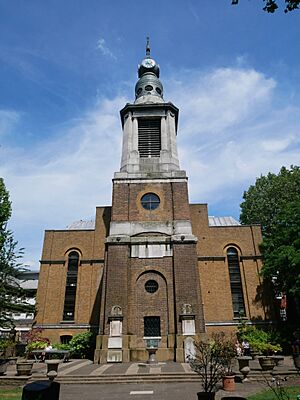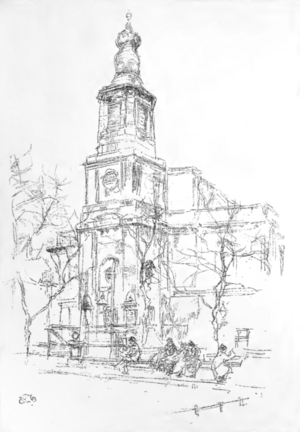St Anne's Church, Soho facts for kids
Quick facts for kids St Anne's Church, Soho |
|
|---|---|

The tower and west end of St Anne's Church.
|
|
| Location | Soho, London |
| Country | England |
| Denomination | Church of England |
| History | |
| Dedication | Saint Anne |
| Dedicated | 1686 |
| Architecture | |
| Architect(s) | William Talman and/or Christopher Wren |
| Years built | 1677–1686 |
| Administration | |
| Parish | St Anne with St Thomas and St Peter, Soho |
| Deanery | Westminster St Margaret |
| Archdeaconry | Charing Cross |
| Diocese | London |
| Province | Canterbury |

St Anne's Church is a special church in the Church of England located in the Soho area of London. It was officially opened on March 21, 1686. Bishop Henry Compton dedicated it as the main church for the new area called St Anne Within the Liberty of Westminster. This new area was created from a part of the larger St Martin in the Fields area. Today, the church is part of the Deanery of Westminster (St Margaret) in the Diocese of London.
Some parts of the churchyard, especially around the west side and the tower, are now a public park called St Anne's Gardens. You can get to it from the Shaftesbury Avenue end of Wardour Street. The church itself is entered through a gate at the end of Dean Street.
Over time, the original church area grew and created two new churches, one for Saint Thomas and one for Saint Peter. But in 1945, these areas joined back together with St Anne's.
Contents
History of St Anne's Church
Building the Church (1677–1799)
The church was named after Saint Anne because Bishop Compton had taught Princess Anne before she became Queen. Building work started in 1677 in what was then the open countryside of Soho Fields. The architects were William Talman and/or Christopher Wren, both very famous designers. The church was planned to be about 80 feet (24 meters) long and 64 feet (20 meters) wide, with a tall 70-foot (21-meter) tower at the west end.
In 1699, a free school for boys was started by the church, and in 1704, girls were also allowed to attend. The church received an organ in 1699 from the Queen's Chapel at St James's Palace. From 1700, the church's first organist was William Croft, who wrote the famous "St Anne" tune for the hymn O God, Our Help in Ages Past. This old organ was later moved to another church in 1798. The church's tower was finally finished in 1718, with a wooden spire added by a local carpenter named John Meard.
Many notable people have connections to St Anne's. Edmund Andros was buried in the churchyard in 1714, and the actress Hester Davenport in 1717. In 1724 or 1725, Edward Harley, 3rd Earl of Oxford and Earl Mortimer, got married here. In 1743, Prince William Henry, who was King George III's younger brother, was baptized at St Anne's. The actress and dancer Arabella Menage was also baptized here in 1782.
Changes and Music (1800–1939)
By 1800, the church tower became unsafe. After many meetings, a new architect, Samuel Pepys Cockerell, was hired to design a new one. The old tower was taken down, but its 1-ton clock bell, made in 1691, was kept and is still used today! The new tower's brickwork was finished by 1801, and its copper dome by May 1803. The ground floor of the new tower became a room for church meetings. Later, it became a room where the clergy (church leaders) get ready. The ashes of the famous novelist Dorothy L Sayers are buried in a deep brick chamber beneath this room. She was a churchwarden (a church official) for a long time. Other people buried in the churchyard in the 1800s include David Williams (1816) and William Hazlitt (1830).
St Anne's Church was well-known for its choir and music from the very beginning. Sir Joseph Barnby was the organist from 1871 to 1888. He was the first person in the UK to perform Bach's "Saint John Passion" (a famous piece of music). The choir even performed for royalty, singing for Queen Victoria at Windsor in 1886 and later for Queen Alexandra at Buckingham Palace. In the 1920s, St Anne's was also the first church to have a religious service with music broadcast on the radio!
Rebuilding and Community (1939–Present)
During the Blitz (a time of heavy bombing in London during World War II), on September 24, 1940, the entire church was burned down, except for the tower, which was left damaged. For a while, services were held in other nearby churches and rooms. By 1949, it seemed the church would not be rebuilt. So, in 1953, the remaining parts of the east wall were taken down, and the land was prepared for sale. The church's area then joined with two other churches, creating the Parish of St Anne with St Thomas and St Peter.
However, the tower was used as a small chapel in the 1950s. It was partly fixed up in 1979 by the Soho Society. Then, in the 1990s, the whole church was rebuilt! The tower was fully restored between 1990 and 1991 and is now a Grade II* listed building, meaning it's a very important historical building. The rebuilding was helped by a new law passed in 1965. Princess Anne laid the foundation stone on March 12, 1990. The new church and its connected buildings were finished and officially reopened on St Anne's Day, July 26, 1991. The new church is designed to be flexible and can be used as a large or small space. It's part of a community center and is a central place for the community, offering support during difficult times, like after a sad event in 1999.
Even when there wasn't a church building, from 1941 to 1958, the St Anne Society, led by Father Patrick McLaughlin, helped connect writers and artists with the Church of England. Famous members included Agatha Christie, T. S. Eliot, and C. S. Lewis. Following the example of earlier church leaders, the church council (formerly called the "Vestry of St Anne's") has been very active in helping London's poor and homeless people. For example, Kenneth Leech started the charity Centrepoint in the basement of St Anne's House in December 1969. Centrepoint stayed at the church until 2023.
Today, St Anne's is a busy church community and a place for many local events and meetings. It also hosts the Soho Society, a charity called Diversity Role Models (which works against bullying), and since January 2024, its own community coffee shop called Sacred Grounds. To celebrate 25 years since the church was rebuilt, a new entrance on Dean Street was opened on December 8, 2016. This new entrance was designed by students from UAL London and won an award for its beautiful and welcoming design.
Rectors of St Anne's Church, Soho
A Rector is the main priest or minister in charge of a church parish. Here is a list of the Rectors who have served St Anne's Church:
- 1686–1704 John Hearne
- 1704–1750 John Pelling
- 1750–1766 Samuel Squire
- 1766–1778 Richard Hind
- 1778–1781 Robert Richardson
- 1781–1806 Stephen Eaton
- 1806–1845 Roderick MacLeod
- 1846–1891 Nugent Wade
- 1891–1914 John Henry Cardwell
- 1914–1929 George Clement Wilton
- 1930–1933 Basil Bourchier
- 1953–1962 Patrick McLaughlin
- 1963–1975 John Frear Hester
- 1978–1984 Michael Barnabas St Leger Hurst-Bannister
- 1985–1998 Frederick Crichton Stevens
- 1998–2007 Clare Marguerite Herbert
- 2007–2011 David Samuel Gilmore
- 2011–2013 William Mungo Jacob
- 2013– Richard Simon Fildes Buckley
See also

